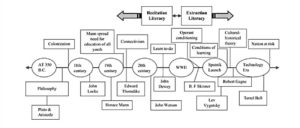The readings, topic notes, and webinar for topic 2 “Historical & theoretical context of K-12 online & open learning in Canada” gave me a new perspective on how far online learning & open learning has come in Canada and also how far it needs to go. Before taking notes and annotating with my peers on the “Handbook of Research on K-12 Online and Blended Learning“, and the blog; “Learning theories and online learning“, my knowledge I realize for this type of learning was very scattered and somewhat incorrect. If anything, before this topic, the closest I got to learning more about online learning and the benefits and difficulties it brings for both the student and the teacher was through watching my two elementary school teacher parents convert over to an online platform.
Learnings based off of notes:
One of the most crucial pieces of information I learned was how “new” and “ill-researched” this topic is. Delving into the readings the very first thought made by me was how it took over 20 years for any form of a re-examination of formal research to be conducted on these topics. My theoretical thinking for this reasoning is that: The dramatic evolution of technological resources and hardware over the past decade has brought vast advancements compared to the course of the past 20 years which is why a new examination of online learning was needed.
 During the course readings I learned a lot about Canada and how it finances its e-learning education, and needless to say I was surprised at times. Compared to the rest of the world Canada ranks quite high amongst the nations of the world in the category of “educational spending per capita” (Barbour, M & Labonte, R, 2018, p. 601). However, each province and territory is responsible for funding, creating curriculum, and managing their educational programs meaning there is no national funding, policy, or governing (I never understood the point of having 13 different curriculums). According to this article and my fellow peer Leona Ngan, the provincial/territorial funding is distributed equally amongst private and public schools on “per-student funding based on enrollment” (Barbour, M & Labonte, R, 2018, p. 601) regardless of the external/independent funding that these schools may be getting elsewhere (Ngan, L, 2020).
During the course readings I learned a lot about Canada and how it finances its e-learning education, and needless to say I was surprised at times. Compared to the rest of the world Canada ranks quite high amongst the nations of the world in the category of “educational spending per capita” (Barbour, M & Labonte, R, 2018, p. 601). However, each province and territory is responsible for funding, creating curriculum, and managing their educational programs meaning there is no national funding, policy, or governing (I never understood the point of having 13 different curriculums). According to this article and my fellow peer Leona Ngan, the provincial/territorial funding is distributed equally amongst private and public schools on “per-student funding based on enrollment” (Barbour, M & Labonte, R, 2018, p. 601) regardless of the external/independent funding that these schools may be getting elsewhere (Ngan, L, 2020).
Historical trends in k-12 online and distributed learning:
1919: Correspondence school opens in Canada, British Columbia
1945-95: First virtual school is established in Canada. Avon Maitland Distance Education Centre in Ontario
1995-96: First virtual school to offer multiple courses opens. Electronic Distance Education Network in Ontario
1995-99: Several K-12 online learning programs are developed and operated in Alberta
2008-12: Distance education and online learning flourishes in all 13 provinces and territories
2013: CANeLearng national non-profit is launched to “provide leadership that champions student success by supporting organizations and educators involved in online and blended learning through networking, collaboration, and research opportunities”
2015-16: Of the 5.1 million students enrolled in education programs in Canada 5.7% of the population was enrolled in e-learning
2017: Francophone K-12 eLearning community is established
2018: Every Canadian province and territory has some form of online distance learning
(Barbour, M & Labonte, R, 2018, p. 602-611)
Theoretical trends in K-12 online and distributed learning:

(Edgar, D, 2012, p. 5)
References:
Barbour, M & Labonte, R. (2018) An Overview of eLearning Organizations and Practices in Canada. In R. Ferdig & K. Kennedy (Eds.), Handbook of research on K-12 online and blended learning (pp. 600-616). Pittsburgh, PA: Carnegie Mellon University ETC Press.
Bates, T. (2014). Learning Theories and Online Learning. [Blog post]. Retrieved fromhttps://www.tonybates.ca/2014/07/29/learning-theories -and-online-learning/.
Edgar, D. (2012). Learning Theories and Historical Events Affecting Instructional Design in Education: Recitation Literacy Toward Extraction Literacy Practices. SAGE Open, 2(4), 1-9, https://doi.org/10.1177/2158244012462707

Hello Kirby!
Great summary and I agree, I too have had many concerns about the lack of research in k-12 online/open learning, confusion over curriculum expectations, sharing of resources and funding policies.
Now that we need to consider online learning and open learning design (as a result of Covid in particular) what are some of the characteristics, suggestions, answers or ideas that you can take from your readings – and course activities – to transition into your future career? I was also wondering about your thoughts and perceptions of open learning in K-12 contexts?
Thank you for sharing,
Kirby, just as Josh stated, I was taken in by the picture you chose as your feature image. The photo reminds me of King George III’s library at the Royal Museum in London (shameless travel boast lol). Your inclusion of a linear timeline was a great way to display your learning, and it felt “like something a teacher would think of.” I loved that you included the quote that Leona had during our group annotating, I’m pretty sure that there is a super-computer housed in her head. Furthermore, the group interpretation of the material was my favourite part of this week as it provided some much-needed reconnection with friends. Your reference to your parents being teachers gave a personal connection to your writing, and it reminded me of the many stories you can tell about their experiences in the classroom. By sharing these stories, you have helped me learn.
Again, great post, it was my pleasure to read, and I look forward to reading more of your work in the future.
Another awesome blog post Kirby!
I really liked how you used effective headings to format your post (summary of your previous knowledge, summary of the articles and what you learnt from them, theoretical trends in k-12 open and distributed learning), which made it super easy to follow and digest. As mentioned by Josh and Timm, your eye-catching visual graphics (cover photo and diagram) worked quite well in increasing reader engagement and understanding of the material. In particular, I thought that your choice in including Edgar’s timeline was really useful as it integrated multiple aspects of history (major world events, theorists and educational themes). I appreciated your comments and concerns regarding the province/territory funding and curriculum management. I also thought that it was confusing how there is no national body for governing/enforcing standard policies for online learning standards across Canada. Further, I liked how you broke down the historical context of open and distributed learning using detailed bulleted points – it provided a helpful and concise summary of the evolving nature of online ed in Canada which I know that I will be referencing in the future!
Keep it up! I can’t wait to read your next post for topic three 🙂